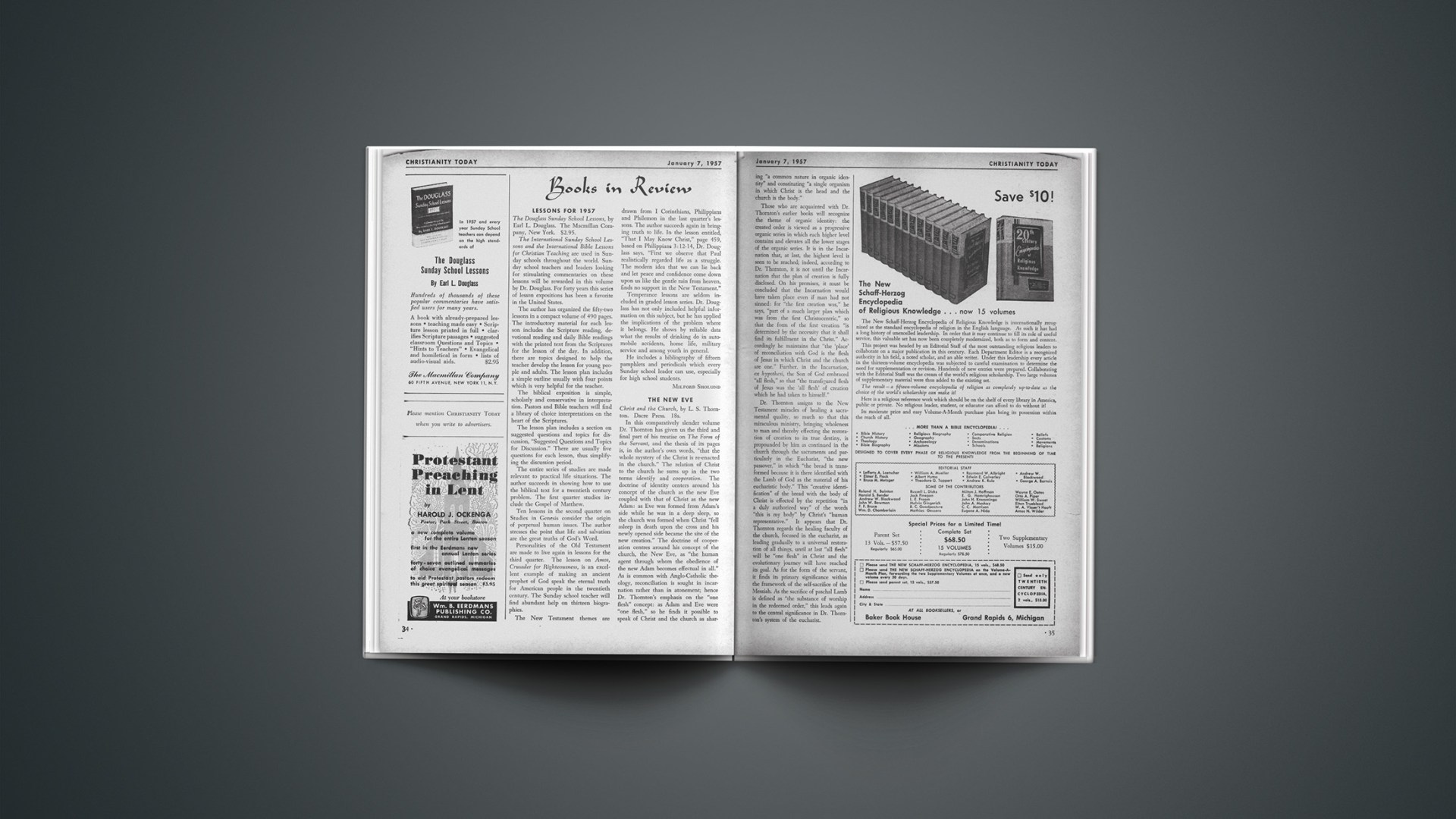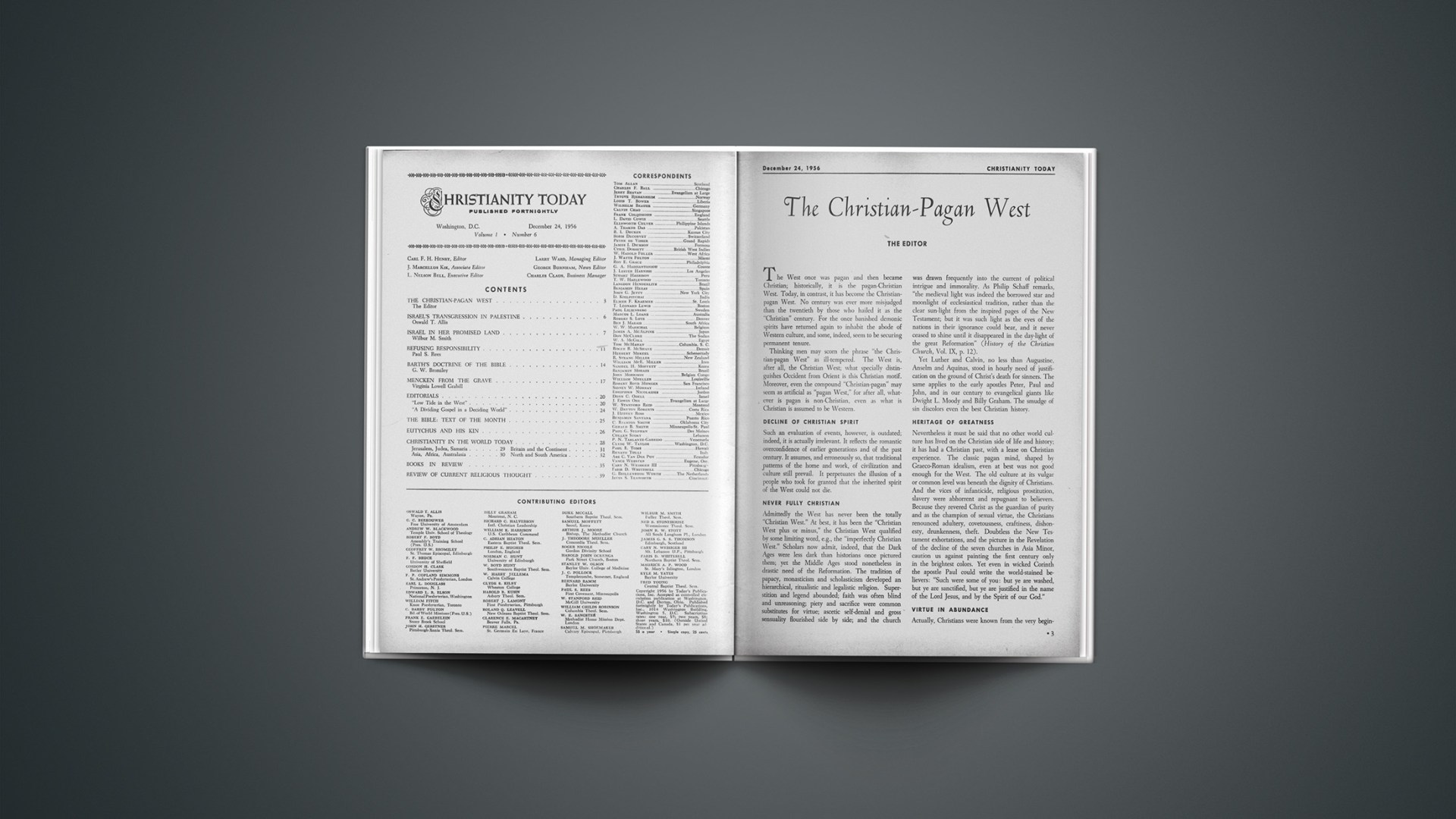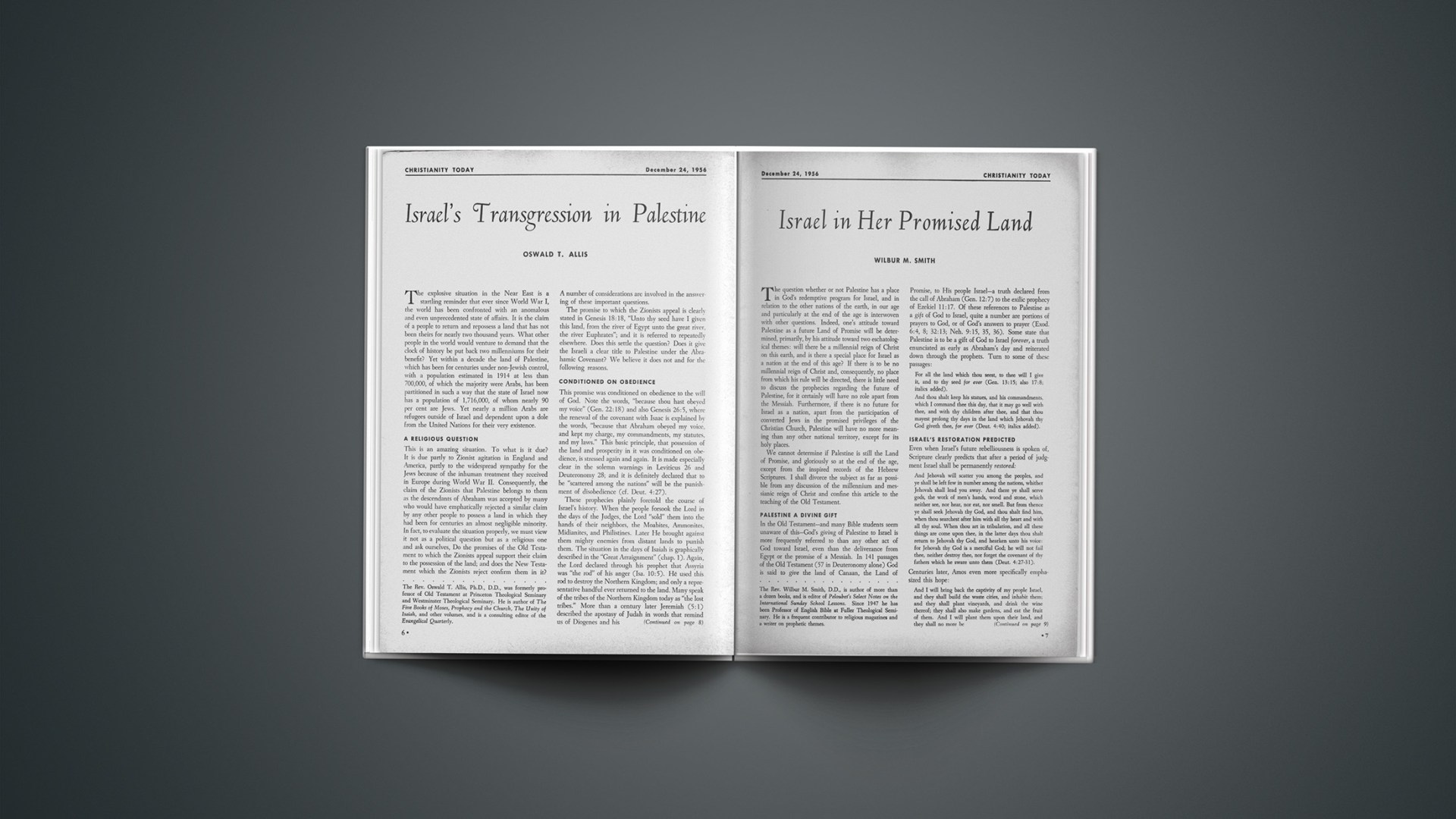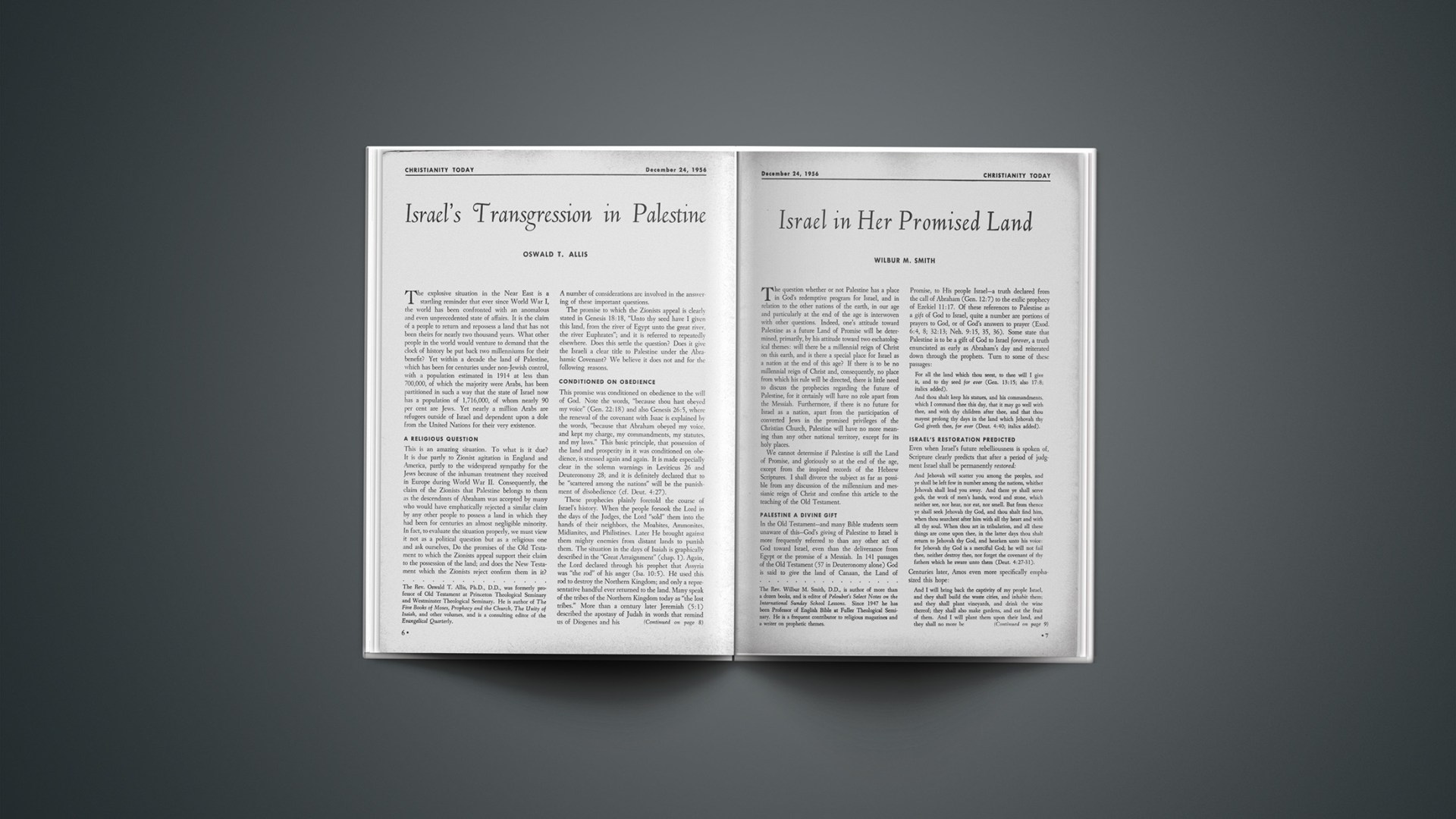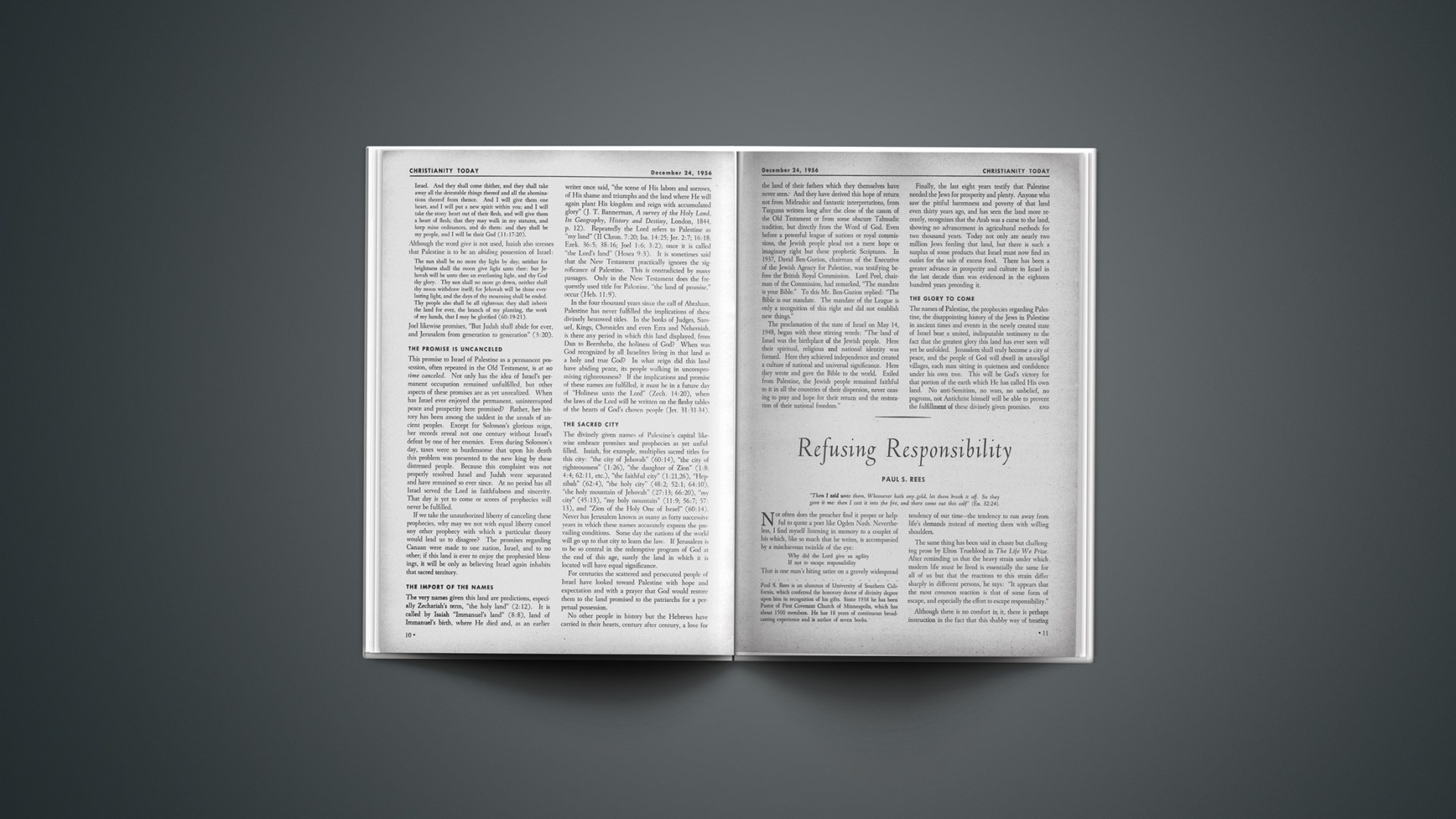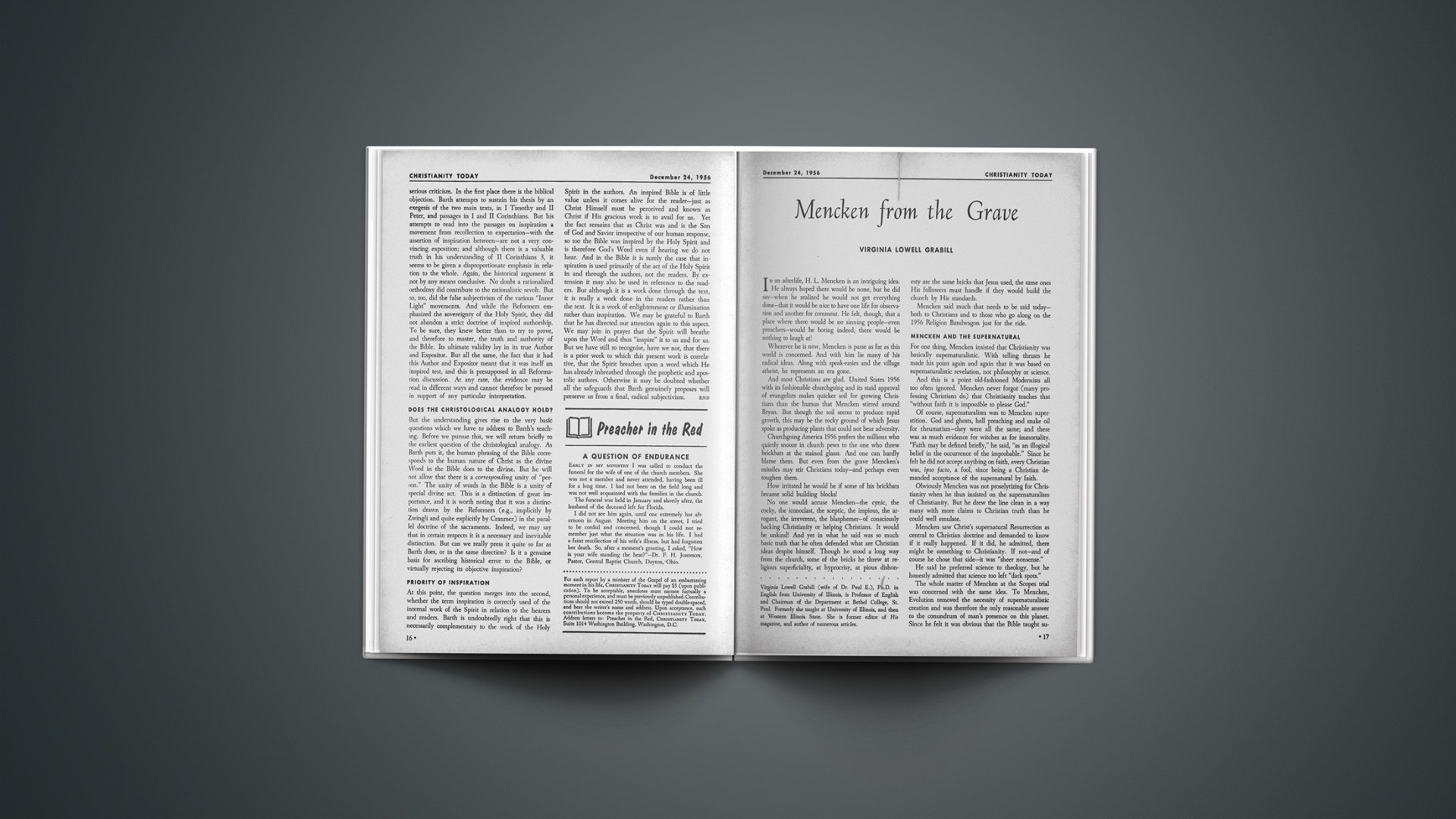Lessons For 1957
The Douglass Sunday School Lessons, by Earl L. Douglass. The Macmillan Company, New York. $2.95.
The International Sunday School Lessons and the International Bible Lessons for Christian Teaching are used in Sunday schools throughout the world. Sunday school teachers and leaders looking for stimulating commentaries on these lessons will be rewarded in this volume by Dr. Douglass. For forty years this series of lesson expositions has been a favorite in the United States.
The author has organized the fifty-two lessons in a compact volume of 490 pages. The introductory material for each lesson includes the Scripture reading, devotional reading and daily Bible readings with the printed text from the Scriptures for the lesson of the day. In addition, there are topics designed to help the teacher develop the lesson for young people and adults. The lesson plan includes a simple outline usually with four points which is very helpful for the teacher.
The biblical exposition is simple, scholarly and conservative in interpretation. Pastors and Bible teachers will find a library of choice interpretations on the heart of the Scriptures.
The lesson plan includes a section on suggested questions and topics for discussion, “Suggested Questions and Topics for Discussion.” There are usually five questions for each lesson, thus simplifying the discussion period.
The entire series of studies are made relevant to practical life situations. The author succeeds in showing how to use the biblical text for a twentieth century problem. The first quarter studies include the Gospel of Matthew.
Ten lessons in the second quarter on Studies in Genesis consider the origin of perpetual human issues. The author stresses the point that life and salvation are the great truths of God’s Word.
Personalities of the Old Testament are made to live again in lessons for the third quarter. The lesson on Amos, Crusader for Righteousness, is an excellent example of making an ancient prophet of God speak the eternal truth for American people in the twentieth century. The Sunday school teacher will find abundant help on thirteen biographies.
The New Testament themes are drawn from I Corinthians, Philippians and Philemon in the last quarter’s lessons. The author succeeds again in bringing truth to life. In the lesson entitled, “That I May Know Christ,” page 459, based on Philippians 3:12–14, Dr. Douglass says, “First we observe that Paul realistically regarded life as a struggle. The modern idea that we can lie back and let peace and confidence come down upon us like the gentle rain from heaven, finds no support in the New Testament.”
Temperance lessons are seldom included in graded lesson series. Dr. Douglass has not only included helpful information on this subject, but he has applied the implications of the problem where it belongs. He shows by reliable data what the results of drinking do in automobile accidents, home life, military service and among youth in general.
He includes a bibliography of fifteen pamphlets and periodicals which every Sunday school leader can use, especially for high school students.
Milford Sholund
The New Eve
Christ and the Church, by L. S. Thornton. Dacre Press. 18s.
In this comparatively slender volume Dr. Thornton has given us the third and final part of his treatise on The Form of the Servant, and the thesis of its pages is, in the author’s own words, “that the whole mystery of the Christ is re-enacted in the church.” The relation of Christ to the church he sums up in the two terms identify and cooperation. The doctrine of identity centers around his concept of the church as the new Eve coupled with that of Christ as the new Adam: as Eve was formed from Adam’s side while he was in a deep sleep, so the church was formed when Christ “fell asleep in death upon the cross and his newly opened side became the site of the new creation.” The doctrine of cooperation centres around his concept of the church, the New Eve, as “the human agent through whom the obedience of the new Adam becomes effectual in all.” As is common with Anglo-Catholic theology, reconciliation is sought in incarnation rather than in atonement; hence Dr. Thornton’s emphasis on the “one flesh” concept: as Adam and Eve were “one flesh,” so he finds it possible to speak of Christ and the church as sharing “a common nature in organic identity” and constituting “a single organism in which Christ is the head and the church is the body.”
Those who are acquainted with Dr. Thornton’s earlier books will recognize the theme of organic identity: the created order is viewed as a progressive organic series in which each higher level contains and elevates all the lower stages of the organic series. It is in the Incarnation that, at last, the highest level is seen to be reached; indeed, according to Dr. Thornton, it is not until the Incarnation that the plan of creation is fully disclosed. On his premises, it must be concluded that the Incarnation would have taken place even if man had not sinned: for “the first creation was,” he says, “part of a much larger plan which was from the first Christocentric,” so that the form of the first creation “is determined by the necessity that it shall find its fulfillment in the Christ.” Accordingly he maintains that “the ‘place’ of reconciliation with God is the flesh of Jesus in which Christ and the church are one.” Further, in the Incarnation, ex hypothesi, the Son of God embraced “all flesh,” so that “the transfigured flesh of Jesus was the ‘all flesh’ of creation which he had taken to himself.”
Dr. Thornton assigns to the New Testament miracles of healing a sacramental quality, so much so that this miraculous ministry, bringing wholeness to man and thereby effecting the restoration of creation to its true destiny, is propounded by him as continued in the church through the sacraments and particularly in the Eucharist, “the new passover,” in which “the bread is transformed because it is there identified with the Lamb of God as the material of his eucharistie body.” This “creative identification” of the bread with the body of Christ is effected by the repetition “in a duly authorized way” of the words “this is my body” by Christ’s “human representative.” It appears that Dr. Thornton regards the healing faculty of the church, focused in the eucharist, as leading gradually to a universal restoration of all things, until at last “all flesh” will be “one flesh” in Christ and the evolutionary journey will have reached its goal. As for the form of the servant, it finds its primary significance within the framework of the self-sacrifice of the Messiah. As the sacrifice of paschal Lamb is defined as “the substance of worship in the redeemed order,” this leads again to the central significance in Dr. Thornton’s system of the eucharist.
It is not possible in the space of a brief review to deal adequately with the important questions raised by a work so closely woven in texture as this. Throughout, in his use and manipulation of Scripture, Dr. Thorton applies the allegorical method in a manner which would have delighted the more imaginative of the early fathers and which bids fair to rival the more esoteric exegesis of certain groups of the Plymouth Brethren, though it may be doubted whether either early fathers or Plymouth Brethren would find themselves able to approve of his major conclusions.
PHILIP E. HUGHES
Semi-Popular
Titles of the Triune God, by Herbert F. Stevenson. Revell, New York, 1956. $2.50.
In the foreword to this American printing of an English work, the following statement is made: “The Bible makes no attempt at a definition of God. What it does is to give us a wealthy characterization of God.” Thus the reader is introduced to the theme of this little volume.
First, a few words relative to the mechanics of the book. The chapters, in the nature of short essays, are organized into three groups: “God,” “Our Lord Jesus Christ,” and “the Holy Spirit.” For the most part, the author has followed a chronological or progressive line of development in the first division of his book and a topical or nominal one in the latter two. Nothing in the way of an exhaustive concordance is furnished.
Second, some remarks relative to the content. There are two basic types of names treated in such a study: those formed from a single word and those formed from a combination of words. In the former class are to be found those deriving content from the word itself, e.g., “Jehovah,” and those of a descriptive nature involving something of the metaphor, e.g., “rock,” “shield,” etc. In the latter class, the general rule submitted is that the first word retains its own meaning while the subsequent word or words is an additional “unfolding of His Person, or will, or provision for His people” (p. 37). New experiences sometimes demanded new names. In some instances these names were ascribed to God by men while in other instances they were pronounced to man by God. In passing from the first division into the second, one moves into an area in which some change in meaning is evident, i.e., prophetic names of the Old Testament move into their New Testament fulfillment in the Incarnate Son and words of common use are given a deep, sacred content. The author’s treatment of the third division, the Names of the Spirit, which he calls a major theme in the New Testament, is Trinitarian and shows how in this area one moves from the vague and implicit Old Testament treatment of the Spirit of God into the concrete and explicit New Testament treatment of the Holy Spirit, the third person of the Trinity.
Third, a brief criticism of the book. For a proper perspective, one must keep in mind what must have been the author’s purpose in writing the volume. It is, first of all, to fill the gap created by the lack of any book treating “all the names and titles of the Three Persons of the Trinity,” (p. 7). Thus the scope is extensive rather than intensive. It is, next, written “not … for scholars but for students—for just plain you and me” (p. 6). Thus the nature and tenor of the book is what one may call “semi-popular.” For the pastor, this book will be extremely suggestive homiletically; for the layman it furnishes a guide for profitable devotional study; and for the scholar, in either group, it gives a good “bird’s eye view” of the subject plus a four page bibliography. The author has not purposed to enter into the arena of theological debate and therefore the expression of his own personal views without development at points is only to be expected, e.g., “the gap theory” (p. 171), his millennial view (p. 87), etc. Occasionally there is, we feel, a tendency to overdo the typology element.
HEINRICH B. EILER
Intelligible To Laymen
God In His World, by Charles S. Duthie. Abingdon Press, Nashville. $2.50.
Testifying that “the events of my own life have compelled me, from very early days, to see how necessary it is to take Christian thought and Christian evangelism with equal seriousness” (p. 7), Dr. Duthie has been concerned to present a theology that will be intelligible to laymen and that will serve them well in their efforts to win others to Christ. Out of a background that includes the pastorate, the chaplaincy, teaching, and participation in the Tell Scotland Movement of evangelism, he writes with a passion and with an ability to state old truths in fresh ways.
The author recognizes that many who previously had no interest in things spiritual are today groping for something that will satisfy their hearts, and he is concerned that the Christian faith be presented to them in an intelligible form. His interest in doctrine is to the end that men may come to know Christ as He is offered in the Word, and that they in turn may be used to bring other groping souls to him.
This is obviously a worthy aim, and it is good to be able to report that in a real measure, the author accomplishes his purpose. Recognizing the importance both of working from the Gospel out to the situation of modern man, and from the situation of man back to the Gospel, he does both effectively. His writing is full of fresh spiritual insights, and whether he is dealing with our beliefs in the persons of the Godhead, or in the opportunities which confront the Church today, his treatment is vigorous and helpful.
Each reader will have his own favorites among the chapters of the book, but there are highlights here that should have the widest appeal. The presentation of the meaning of surrender in the closing chapter of the book, for example, is a masterpiece. Dr. Duthie describes it under the headings of capitulation, acceptance, communion and confidence. Developing these thoughts, he shows that in the biblical sense, surrender is giving in to God, taking in from God, drawing near to God and trusting in God.
All of which is not to say that there are not occasional disappointments in the book. Dr. Duthie gives a central place to Christ’s redemptive work on the cross, but he cannot quite bring himself to admit that Christ was punished for our sins (p. 33). He seems to feel that the formation of the World Council of Churches marks a major step forward in Christian unity. His acknowledged indebtedness to liberal scholars is at times disturbing. But without denying or minimizing these disappointments, it must be said that Dr. Duthie has something for us, and that his message is well worth heeding.
H. L. FENTON, JR.
Faith Fades Away
Sermons from an Ecumenical Pulpit, edited by Max F. Daskam. Starr King, Boston. $5.50.
The Unitarian fellowship of German-town (it doesn’t say where, but presumably that is the Boston influence) does not have a resident minister. Instead, this congregation invites prominent preachers of every faith to occupy its pulpit for a few Sundays at a time. The plan has been in operation for twenty years and if the sermons in this book faithfully represent the result, the pulpit committee must draw its names from Who’s Who among America’s pulpiteers. Niebuhr, Tillich, Paul Scherer, James Cleland, Van Dusen, Fosdick, McCracken and Norman Thomas are among the many who contributed one sermon each to this collection.
“But how,” Max F. Daskam, the editor, reports they often are asked, “can you have (all denominations) in one pulpit? Don’t they contradict one another?” By way of reply Mr. Daskam reports that it is their experience that “denominational differences tend to fade away as our guest ministers stress the great and eternal truths of our Christian faith.” He would have spoken more accurately had he said that in these sermons whatever is explicit about the Christian faith tends to fade away.
The sermons are collected under significant headings, such as: I. What Goodness for Man; III. The Nature of Jesus; VI. The Larger Hope. When the time comes for him to speak, Niebuhr affirms the impossible possibility of human perfection; Tillich, that one can be righteous and yet feel no relief because little is forgiven him; Rabbi David W. Wise, that a true God-concept is one which does not fractionalize the Universe, accepting pleasure, for instance, but not pain, but is one which accepts all of life and substance as a part of God and His never-ending process; Harry C. Meserve, that you understand Jesus when you see Him to have been a man who found his vocation, that of a religious teacher, and went about talking, “not even about God, or any significant religious idea, but about the life that he found around him” with its necessities to maintain faith amid corruption and to get along with other human beings; Cleland, that we must get to know Jesus if we are to fit our lives to the ethical discernments and demands of our Lord and Master, for only in loving Him will we grow more like Him until our new conduct becomes second nature with us—theologically, this means re-birth; Elton Trueblood, that true freedom follows the recovery of the disciplined Christian life; Bishop Oxnam, that the ideals of a peaceful world and a unified church can be kept alive if we keep close to Jesus who incorporated those ideals; and Halford Luccock, that Easter is far more than an affirmation about the length of life, it is a symbol of the reality and the triumph of the spiritual world, the miracle of a life lived in a new relationship to God.
These are beautiful sermons. They are so beautiful, in fact, that almost everyone would enjoy reading them. But I am reminded that it is occasionally possible to string beautiful sentiments together without preaching the Scriptures. And this book suffers from the scarcity of a clear Word unto Salvation.
G. AIKEN TAYLOR
Psychological Approach
The Pastoral Epistles and the Mind of Paul, by Donald Guthrie, Tyndale, London. 1s.6d.
This pamphlet of 44 pages reproduces the Tyndale New Testament Lecture for 1955; it deals with a subject to which the lecturer, who is Tutor in New Testament in London Bible College, has devoted special study for a number of years.
In contemporary discussions of the New Testament Epistles, it is generally taken for granted that the three Pastoral Epistles—the two addressed to Timothy and one to Titus—cannot, as they stand, be ascribed to Paul. Some regard them as completely pseudonymous (one German scholar has recently suggested that they were composed by Polycarp of Smyrna, martyred in A.D. 156); others recognize genuine Pauline fragments embedded in them. Among the latter the most eminent name is that of the veteran English scholar P. N. Harrison, whose painstaking study, The Problem of the Pastoral Epistles (1921), has perhaps done more than any other work to convince scholars that Paul was not the author of these letters in their present form. Yet the case against Pauline authorship has not been permitted to make its way without contradiction; commentaries maintaining their authenticity have been produced in recent years by Jeremias in Germany, by Spicq in France, and by E. K. Simpson in England and the scholarship of these writers is unimpeachable.
Mr. Guthrie defends the genuineness of the three epistles from the psychological point of view. His approach involves linguistic and doctrinal considerations. Dr. Harrison laid particular stress on the differences in style and vocabulary between the earlier Pauline letters and the Pastorals. Mr. Guthrie does not challenge Dr. Harrison’s data, but claims that other data must be taken into account as well and that the inferences drawn from the data by Dr. Harrison are not so certain as many suppose. To make the situation clearer, he supplies at the end of his study (among other linguistic appendixes) a list of particles and other small words which constitute the connective tissue of language, comparing their use in the Pastorals with their use in the earlier epistles.
Paul’s increasing years and the changing needs of the church account for the less dynamic approach and more formalized theology of the Pastorals. In an examination of the summaries of the doctrine called the “faithful sayings,” Mr. Guthrie points out that, with the exception of that in 1 Timothy 3:1 (where, it might be added, the Western text reads “popular” instead of “faithful”), the doctrine summarized is thoroughly Pauline.
Mr. Guthrie does not shirk the difficulties which a defender of the epistles’ authenticity has to face, but he concludes that the difficulties inherent in the pseudonymous and fragmentary theories are greater, especially on the psychological side. His arguments ought to receive the serious attention of all careful students of the New Testament.
F. F. BRUCE
Christian Verse
The Valley of Silence, by Jack Shuler. Zondervan, Grand Rapids.
This well-printed and attractively bound volume contains 94 selections. Some of them are by such well known writers as Annie Johnson Flint, Grace Noll Crowell and Ella Wheeler Wilcox, and there is one each by John Greenleaf Whittier, Rudyard Kipling and Charles Dickens. Forty-two of the pieces are listed as by unknown authors. Sometimes a textual comparison with such a book as J. D. Morrison’s Masterpieces of Religious Verse would have improved the printed version, e.g., in “Making Harbor” where about half the first stanza is omitted in Shuler’s collection.
These selections are fairly uniform in quality. They belong, however, not to poetry proper but to verse. In the Foreword the publisher describes them as “writing for every occasion … the fitting conclusion to a sermon, the effective opening to a speech.” Verse lends itself to such ends; poetry does not. Genuine poetry operates in a different capacity than to gild the lily. It is not decorative but rather carries its own essential autonomy. It penetrates not with the pin prick of a self-evident moral but with a massiveness which is as freighted with meaning as life itself. Verse can afford to be facile, clever, ingenious. Poetry proper is original, expansive and generative. Verse may toy with an idea; poetry thrusts toward truth itself. Verse is generally satisfied with a mere twist of meaning; poetry presents the genuinely significant. Verse is descriptive; poetry presentational and symbolic. Verse is usually practical and didactic; poetry, if it is to be called functional at all, is functional at the root of man’s being. In a word, verse may deal with the surface of things, but poetry will content itself with nothing less than the center.
The selections in Mr. Shuler’s book are as good as the average of Christian verse, but too often they are marked by the inevitable characteristics—cliches, forced rhymes, padded lines and the like. The time is ripe for orthodox Christians with a gift for writing to attempt devotional verse in the great tradition of literature itself.
CLYDE S. KILBY
Simple Testimony
The Angel Spreads her Wings, by Maxine Garrison. Revell, Westwood, New Jersey.
This is a book about a book. Maxine Garrison, a friend of Dale Evans and Roy Rogers, tells the story behind the writing of Dale’s little book, Angel Unaware.
She tells the heartache and faith behind the writing of that beautiful volume and describes the way in which it was received by the public. Many quotes are given from letters received by Dale Rogers showing how her simple testimony of the mission of her frail, short-lived, Mongoloid daughter has inspired and comforted others, particularly those with similar experiences.
As interesting as it is, I regret that no mention is made in this book of the precise nature of Dale Evans’ faith. In Angel Unaware we see her insistence upon a proper relationship with Christ. Edwin Orr vouches for Dale’s genuine Christian faith in his book, The Truth Behind the Hollywood Christian Group. But if one reads Maxine Garrison’s book alone, he gathers, I am afraid, that Dale’s faith is some beautiful, mystical thing having little or no connection with orthodox Christian faith.
NORMA R. ELLIS
Composite Volume
Encyclopedia of Morals, edited by Vergilius Ferm. Philosophical Library, New York, 1956. $10.00.
Here is another composite volume edited by tha indefatigable compiler, Vergilius Ferm. The first entry on the Aboriginals of Yirkalla emphasizes the statement in the Preface that the material is not only philosophical but also anthropological.
Then when we come to Puritan Morals (12 pages, double columns), we find more description of their allegedly disagreeable conduct than exposition of theory. The articles on Aristotle, Kant, and Sidgwick are well written. The difficulties, particularly in the last two thinkers, are lightly touched on, as may be wise in an Encyclopedia; Aristotle receives more criticism, though the total effect is not so clear. Christian Moral Philosophy (49 columns) dates the Mosaic Law after the prophets and claims that the Pharisees were the legitimate heirs of Ezekiel, but in contrast with this radical view the author recognizes the eschatological theme of the Sermon on the Mount and gives a tolerably good account of Romans. Justification by faith is explained, and the infliction of a penalty on Christ is acknowledged.
As it is impossible to review every article in an encyclopedia, these must suffice as samples.
GORDON H. CLARK

